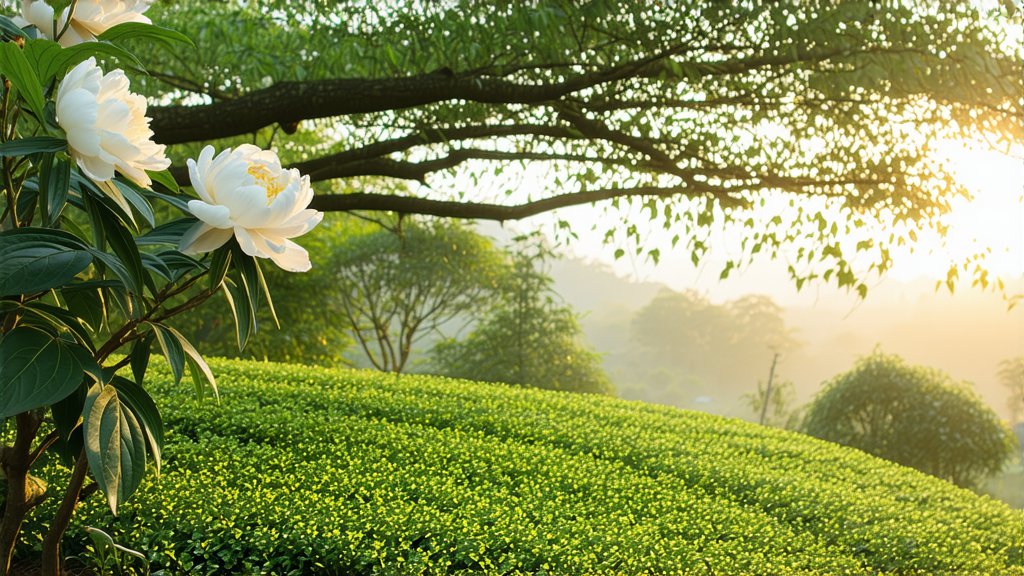
Bai Mudan, often referred to as the "White Peony" in English, is one of the most celebrated varieties within the Chinese white tea category. Originating from Fuding County in Fujian Province, this exquisite tea holds a significant place in both the history and contemporary culture of tea across China and beyond. In this detailed exploration, we will delve into the historical background, types, production processes, and tasting techniques that make Bai Mudan a unique and cherished beverage worldwide.
Historical Background
The history of Bai Mudan dates back to the early Qing Dynasty, around 1796. According to legend, Bai Mudan was discovered by chance when a local tea farmer named Chen Zhongshu observed that certain tea plants produced buds that were covered with fine white downy hairs. These buds, resembling the delicate petals of a white peony flower, inspired the name Bai Mudan. Over time, the tea gained popularity for its distinct flavor profile and health benefits, eventually becoming one of the most revered white teas in China.
Types of Bai Mudan
Bai Mudan comes in two primary grades, distinguished by the proportion of buds to leaves:
-
Bai Mudan Grade I (Silver Needle): This highest grade consists entirely of young tea buds, which are plucked before the leaves have fully opened. The buds are covered in fine white hairs, giving them an appearance similar to silver needles. This grade is considered the most premium and has a subtler, more delicate flavor compared to the lower grade.
-
Bai Mudan Grade II: This grade includes both buds and partially opened leaves. It offers a more robust flavor profile while still retaining the characteristic qualities of Bai Mudan. The presence of leaves contributes additional complexity and depth to the brew.
Production Process
The production of Bai Mudan involves several meticulous steps that preserve its natural flavors and nutritional properties. Here’s a detailed look at the traditional process:
-
Plucking: The finest Bai Mudan leaves and buds are hand-picked, typically in early spring when they are young and tender. Only the top two leaves and the bud are harvested to ensure high quality.
-
Withering: The freshly picked leaves and buds are spread out thinly on bamboo mats or trays and left to wither under natural sunlight or indoors with controlled temperature and humidity. This step allows the moisture content to decrease gradually, softening the leaves and making them more pliable for the next stage.
-
Drying: After withering, the leaves undergo further drying. This can be done using low heat to prevent the delicate leaves from being damaged. The drying process ensures that the leaves retain their natural white down and develop their distinctive flavor.
-
Sorting and Packaging: Once dried, the tea is sorted to remove any imperfect leaves or stems. The final product is then carefully packaged to maintain its freshness and quality until it reaches the consumer.
Tasting Techniques
Tasting Bai Mudan is an art form that requires attention to detail and an appreciation for subtle flavors. Here’s a guide to help you fully experience the nuances of Bai Mudan:
-
Preparation: Use a transparent glass teapot or a Gaiwan (a traditional Chinese tea cup with a lid and saucer) to observe the unfurling of tea leaves during brewing. Preheat the teapot or cups with boiling water to warm them up.
-
Water Quality: Use fresh, filtered water heated to about 80-85°C (176-185°F). The purity and temperature of the water significantly impact the flavor and aroma of the tea.
-
Leaf to Water Ratio: For every 150 ml of water, use approximately 3-5 grams of Bai Mudan leaves. You can adjust this ratio based on your personal taste preference.
-
Steeping Time: The first infusion should be shorter, around 10-15 seconds, to allow the leaves to awaken. Subsequent infusions can be progressively longer, up to 30 seconds or more, depending on your desired strength and flavor intensity.
-
Observing the Leaves: As the leaves steep, watch how they unfurl and release their natural oils and aromas. Bai Mudan leaves are known for their graceful movement and pale yellow-green coloration in the water.
-
Aroma and Flavor: Bai Mudan offers a complex bouquet of floral and fruity notes, often described as having hints of honey, melon, and apricot. The taste is smooth, slightly sweet, and refreshing with a clean, crisp finish. Pay attention to the evolving flavors with each infusion.
Cultural Significance
In Chinese culture, Bai Mudan is not just a beverage but a symbol of elegance and refinement. It is often served during important gatherings, ceremonies, and celebrations. Its delicate nature makes it a favorite among connoisseurs who appreciate the subtler aspects of tea drinking. Additionally, Bai Mudan is praised for its potential health benefits, including antioxidant properties, support for immune function, and promotion of cardiovascular health.
Conclusion
Bai Mudan stands as a testament to the rich heritage and artistry of Chinese tea culture. From its storied origins to its intricate production process and sophisticated tasting rituals, Bai Mudan encapsulates the essence of what makes white tea so special. Whether enjoyed for its health benefits, cultural significance, or simply its delightful flavor profile, Bai Mudan continues to captivate tea enthusiasts around the globe. Embrace the tranquility and elegance of Bai Mudan, and let each sip transport you to the misty mountains of Fujian Province where this extraordinary tea begins its journey.